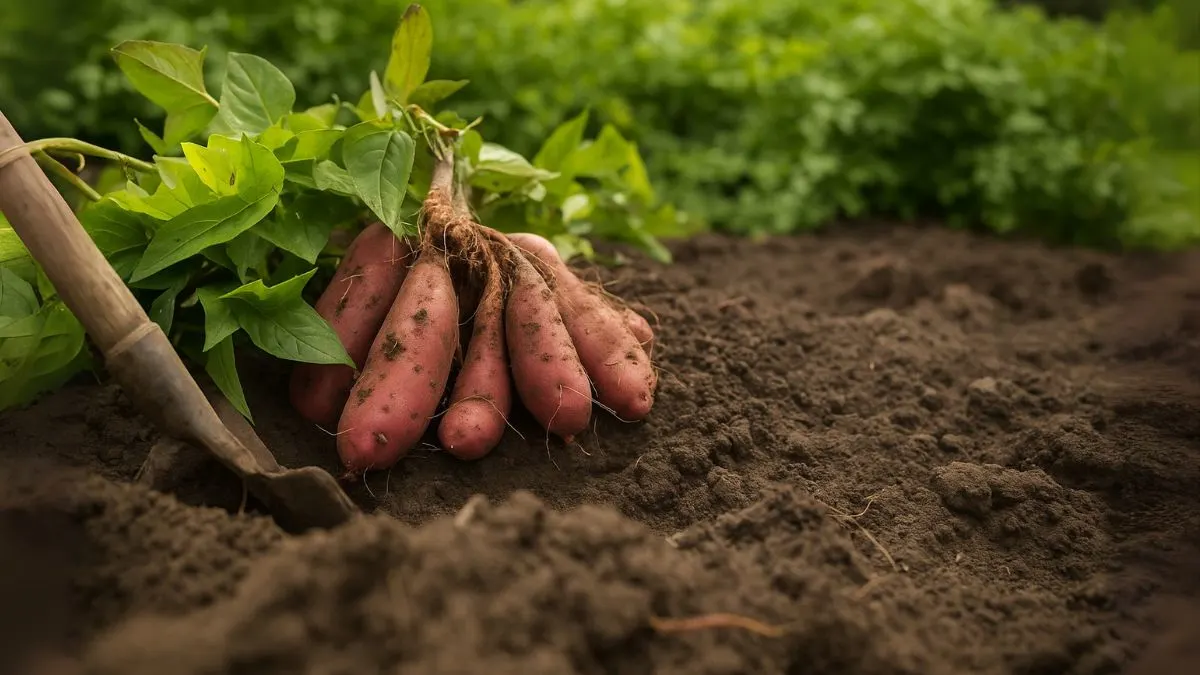Growing Sweet Potatoes at home is one of the most rewarding gardening experiences. Known for its delicious flavor, high nutritional value, and versatile use in global cuisines, sweet potato is a crop that thrives when given the right care. The best part? It grows well in warm regions worldwide, including India, Canada’s southern zones, and across the USA.
Why Grow Sweet Potato?

- A rich source of fiber, vitamins, and antioxidants.
- Easy to grow in gardens, raised beds, and large containers.
- Long vines make it visually appealing as well as practical.
- Yields a generous harvest with relatively low maintenance.
- Adaptable to warm climates across the globe.
When I first tried growing sweet potato in my backyard, I was amazed at how quickly the slips took root. With proper soil preparation and warmth, the harvest was bountiful and tastier than store-bought ones.
Getting the Soil Right
The foundation of success lies in getting the soil right.
- Sweet potato grows best in loose, well-drained, sandy loam soil.
- Avoid cultivation of sweet potato in very light sandy and heavy clayey soil as these either dry out too quickly or retain too much water, leading to poor growth.
- Ideal pH: 5.8 to 6.2.
- Add compost or organic matter to improve fertility.
I once planted sweet potatoes in clay-heavy soil, and the roots came out small and misshapen. After switching to loose, sandy soil, the vines grew vigorously, and the tubers were healthier.
Also Read: Petunias: The Flower That Turns Any Balcony Into a Blooming Paradise
When to Plant Sweet Potato
Sweet potato thrives in warmth, so timing is crucial.
- Plant sprouted new shoots (called “slips”) after the soil has warmed to 65°F.
- They shouldn’t be planted until your soil is quite warm.
- Ideally, they need to be planted when the soil has reached a temperature above 70 degrees.
- In temperate countries like Canada and the northern USA, late May to early June is ideal.
- In India or southern USA, planting can start earlier as warm soil conditions arrive faster.
Planting Sweet Potato Slips
Sweet potato is not grown from seeds but from slips.
- Buy or prepare slips from sprouted tubers.
- Loosen the soil deeply (12–18 inches) for root expansion.
- Space slips 12–18 inches apart in rows.
- Plant them at a depth of 3–4 inches, burying part of the stem.
- Keep the soil consistently moist until plants establish.
Sunlight and Watering Needs
- Sweet potato loves warmth and sunlight. Ensure at least 6–8 hours of direct sun daily.
- Water consistently, especially during the first 4 weeks, to help vines establish.
- Once established, reduce frequency but water deeply.
- Overwatering may cause tubers to rot, so keep soil moist but not soggy.
Care and Maintenance
- Mulch the soil to retain moisture and suppress weeds.
- Trim long vines occasionally to redirect energy into tuber formation.
- Fertilize lightly with potassium-rich fertilizer; avoid excess nitrogen which encourages vine growth over tubers.
- Rotate crops every 2–3 years to prevent soil-borne diseases.
Also Read: Clematis: The Climbing Vine That Gives You a Wall of Blooms
Growth Timeline
Stage |
Duration (Approx.) |
Slips planted |
Soil temp 65–70°F |
Vines established |
2–3 weeks |
Root expansion begins |
6–8 weeks |
Harvest-ready tubers |
90–120 days |
Common Challenges
- Cool Soil: Slips planted in soil below 65°F often fail to grow.
- Pests: Sweet potato weevils and aphids can attack; regular checks and neem oil sprays help.
- Diseases: Fungal rots may occur in poorly drained soils.
- Overfertilization: Too much nitrogen results in leafy vines but fewer tubers.
Harvesting Sweet Potato
- Sweet potatoes are ready to harvest in 90–120 days.
- Look for yellowing leaves as a sign.
- Loosen the soil gently to avoid damaging tubers.
- Cure tubers by drying them in a warm, well-ventilated area for 7–10 days. This improves sweetness and storage life.
The first time I harvested my homegrown sweet potatoes, I was surprised by the yield. A few slips gave me several pounds of rich, orange tubers that stored well for months.
Also Read: Why Insectivorous Plants Are Nature’s Smartest Hunters
Key Requirements for Growing Sweet Potato
Requirement |
Details |
Soil |
Loose, sandy loam; avoid heavy clay or very sandy soils |
Temperature |
Plant sprouted new shoots (called “slips”) after the soil has warmed to 65°F |
Planting Time |
Shouldn’t be planted until your soil is quite warm; need to be planted when the soil has reached a temperature above 70 degrees |
Spacing |
12–18 inches apart |
Sunlight |
6–8 hours daily |
Watering |
Consistent moisture, avoid overwatering |
Harvest |
90–120 days |
Personal Experience
In my early attempts at growing sweet potato, I planted slips too early in cool soil. They failed to take off, leaving me disappointed. Later, I waited until the soil warmed above 70°F, and the difference was dramatic. The slips established quickly, vines flourished, and the harvest was abundant. It was a reminder that patience and getting the soil right are non-negotiable for success.
Sweet potatoes are one of the easiest and most nutritious crops to grow at home if you give them the right conditions. With proper care, your garden will reward you with sweet, flavorful tubers that can be stored for months and enjoyed in countless dishes.






